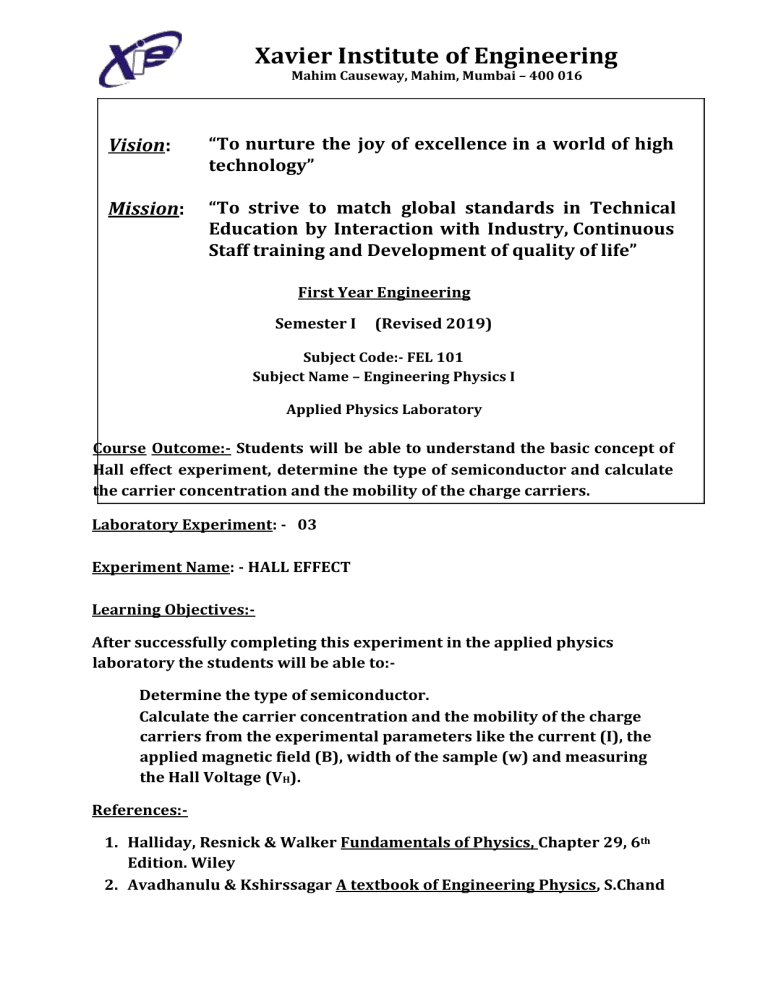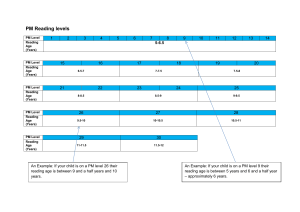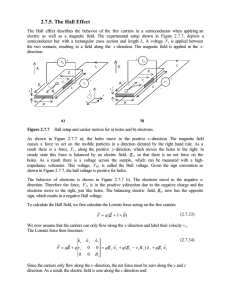
Xavier Institute of Engineering Mahim Causeway, Mahim, Mumbai – 400 016 Vision: “To nurture the joy of excellence in a world of high technology” Mission: “To strive to match global standards in Technical Education by Interaction with Industry, Continuous Staff training and Development of quality of life” First Year Engineering Semester I (Revised 2019) Subject Code:- FEL 101 Subject Name – Engineering Physics I Applied Physics Laboratory Course Outcome:- Students will be able to understand the basic concept of Hall effect experiment, determine the type of semiconductor and calculate the carrier concentration and the mobility of the charge carriers. Laboratory Experiment: - 03 Experiment Name: - HALL EFFECT Learning Objectives:After successfully completing this experiment in the applied physics laboratory the students will be able to:Determine the type of semiconductor. Calculate the carrier concentration and the mobility of the charge carriers from the experimental parameters like the current (I), the applied magnetic field (B), width of the sample (w) and measuring the Hall Voltage (VH). References:1. Halliday, Resnick & Walker Fundamentals of Physics, Chapter 29, 6th Edition. Wiley 2. Avadhanulu & Kshirssagar A textbook of Engineering Physics, S.Chand Title Page of write up Name of the Experiment:- A Study of Hall Effect in Semiconductors Name:- Mark Fernandes Div: A Roll No. :- 20 Date of Performance:- 03/03/2022 Format of the experiment report to be written 1. 2. 3. 4. Title Page Aim of the experiment Apparatus of the experiment Relevant formulae (to be written on the blank side of the page using pencil) 5. Theory of Hall Effect 6. Procedure of the experiment 7. Observation table (to be written on the blank side of the page sing pencil) 8. Data Analysis & Calculation (to be written on the blank side of the page using pencil) 9. Result (Diagrams / Circuit diagrams to be drawn on the blank side of the page using pencil) A Study of Hall Effect in Semiconductors Aim: - The objectives of the experiment are: (i) To determine the hall coefficient of a semiconductor. (ii) To determine the sign of majority carriers in the semiconductor. (iii) To determine the concentration of the majority carriers and (iv) To determine the mobility of the majority carriers in the material. Apparatus: The following apparatus is required to perform the experiment :(i) an extrinsic semiconductor wafer, (ii) a constant current source, (iii) an electromagnet and (iv) a voltmeter having high input impedance. Formulae: - i) The Sign of the majority carriers is found from the polarity of Hall voltage, VH. ii) The Hall coefficient RH is calculated from 𝑅𝐻 = iii) ( 𝑉𝐵𝐻..𝐼𝑏 )𝑝 = Theconcentration of charge carriers is obtained from of the carriers is calculated from µ = σ x R 𝐻 H 𝑅1. 𝑒 𝑛 = 𝑅1. 𝑒 or iv) The mobility 𝐻 Theory:- If piece of conductor (metal or semiconductor) carrying a current is placed in a transverse magnetic field, an electric field is produced inside the conductor in a direction normal to both the current and the magnetic field. This phenomenon is known as the “Hall Effect” and the generated voltage is called the “Hall Voltage”. Let us assume that the material is an n- type semiconductor. The current flow consists of almost entirely of electrons moving from right to left. Thus the direction of conventional current is in the +ve direction of X-axis. The magnetic field is in the +ve Z- axis. If ‘v’ is the velocity of the electrons at right angles to the magnetic field, there is a downward force on each electron of magnitude Bev. This causes the electrons to be deflected in a downward direction and thus a –ve charge accumulates on the bottom face (Face1). A potential difference between top(face2) and bottom (Face1) face of slab with top face becoming positive. This causes a electric field EH in a –ve direction and so a force of eEH acts in upward direction. In equilibrium, The electric field intensity EH balances the magnetic force on the charge carriers. ∴𝑒𝐸𝐻 = 𝐵𝑒𝑣 → 𝐸𝐻 = 𝐵𝑣 −−−−−− (1) A hall voltage VH is generated across the sample of thickness ‘d’ given by, Now the current density in the X-direction is,𝑉𝐻 = 𝐸𝐻𝑑 𝑜𝑟 𝐸𝐻 = 𝑉𝑑𝐻 −−−−− (2) Where n is the concentration of current carriers.𝐽𝑥 = 𝑛𝑒𝑣 −−−−−−− (3)……. (𝑜𝑟 𝑣 = 𝑛𝑒𝐽𝑥 ) Substitute the value of ‘v’ from the equation 3 in equation 1, Thus we have, 𝐸𝐻 = 𝐵𝑛𝑒𝐽𝑥 𝑜𝑟 𝐸𝐻 = 𝑅𝐻𝐽𝑥𝐵 −−−−−− (4) Where, 𝑅𝐻 = 𝑛𝑒1 = Hall Co-efficient -----------------------(5) (in this case ∴𝑅𝐻 = − 𝑛𝑒1 as the electro field developed is in –ve Y-direction.) (From Equation 2, the Hall Voltage is given by,Similarly for p-type semiconductor, the current is entirely by holes, ∴𝑅𝐻 = 𝑝𝑒1 Where d is the sample thickness. 𝑉𝐻 = 𝐸𝐻𝑑 Substitute the value of EH from equation 4, We have, 𝑉𝐻 = (𝑅𝐻𝐽𝑥𝐵)𝑑 −−−−− (6) Now if ‘w’ is the width of the sample, then the cross sectional area of the specimen will be given as “w.d”. The current density 𝐽𝑥is given as, Thus substituting the value of Jx in equation 6, we have,𝐽𝑥 = 𝐼𝐴𝑥 = 𝑤𝐼.𝑥𝑑 Thus we can write, 𝑉𝐻 = 𝑅𝐻 ( )𝐵. 𝑑 𝑤𝐼.𝑥𝑑 𝐻 𝑜𝑟 𝑉 𝐻 = 𝑅𝐻 ( )𝐵 𝐼𝑤𝑥 𝑅𝐻 = 𝑉𝐼𝑥..𝐵𝑤 −−−−−−− (7) The conductivity (σ) and the mobility (µ) are related as, σ = µne µ = 𝑛𝑒σ = σ. 𝑅𝐻 −−−− (8)…. 𝑠𝑖𝑛𝑐𝑒 𝑅𝐻 = 𝑛𝑒1 Thus by measuring V→µ =H, Ix , B and v & by knowing σ ( 𝑉𝐼𝑥𝐻..𝐵𝑤 ) −−−− (9)σ……, the mobility µ can be determined.(𝑓𝑟𝑜𝑚 𝐸𝑞𝑢𝑎𝑡𝑖𝑜𝑛 7) By considering the random thermal distribution of speed of the charge carriers, The Hall Co-efficient is defined as, For n-type material, 𝑅𝐻 = 83π𝑛𝑒 = 1𝑛𝑒.18 −−− (10) The conductivity is given by, µ𝑛 = 𝑛𝑒µ𝑛 µ𝑛 = 𝑛𝑒σ𝑛 = − σ1𝑛.18𝑅𝐻 ……(𝑓𝑟𝑜𝑚 𝑒𝑞𝑢. 10) For p-type material, The conductivity is given by, µ𝑝 = 𝑝𝑒µ𝑝 Circuit Diagram:- µ𝑝 = 𝑝𝑒σ𝑝 = σ1𝑝.18𝑅𝐻 ……(𝑓𝑟𝑜𝑚 𝑒𝑞𝑢. 10) Procedure: 1) PROBE CURRENT AGAINST PROBE OUTPUT CHARACTERISTICS a. Set the magnet current at any desired value. Note down the current. Do not disturb this setting throughout this experiment. b. Set the probe current at + or – 100 mA. Adjust ZERO control so that PROBE OUTPUT meter reads Zero. Do not disturb this control. c. Carefully insert the probe through plastic nut provided on the top of the electromagnet. Turn it around so that the plane of the probe is parallel to the face of the pole pieces. Also make sure that the probe tip is at the center of the pole. Do not disturb the probe till the end of the experiment. d. Note down the various value of probe output voltage corresponding to different current setting. As the direction of current changes the direction of probe output voltage will also change. e. Repeat the procedure for different values of Magnet Current. 2) MAGNETIC FIELD AGAINST PROBE OUTPUT VOLTAGE a. Set PROBE current at any desired value. Do not change till end. b. Adjust probe ZERO control if necessary. c. Start the MAGNET current from ZERO and increase it to + 500 mA in steps of 50 mA. Note down the probe output for each current setting. Now decrease the current in steps of 50 mA and note down probe output. Change the current in decreasing negative direction in steps of 50 mA and note down the probe output. d. Repeat the procedure for various values of probe Current. Observation: Thickness of the semiconductor wafer ‘t’ :- 0.013 cm. Resistivity ‘ ρ’ : 0.16 ohm.cm TABLE – I Magnetic field, B = 330 Gauss Sr. No. Current I mA Hall Voltage VH mV 1 10 0.26 2 20 0.45 3 30 0.71 4 40 0.91 5 50 1.14 6 60 1.37 7 70 1.58 8 80 1.82 9 90 2.03 10 100 2.24 Data Analysis & Calculation:1) Hall Co-efficient:- 𝑅𝐻 = 𝑉𝐻×𝐼×𝑡×𝐵108 0.013330 × 108 ÷ 330 =2.886= 0. 0222× 10×4 ÷ = 87.454cm3/c Graph : 2) The concentration of charge carriers:𝑛 = 𝑅𝐻1.𝑒 𝑜𝑟 𝑝 = 𝑅𝐻1.𝑒 = 7.1376x1016 cm3 3) Mobility of charge carriers:µ = = 6.25 x 87.454 σ. 𝑅𝐻 = 546.5909 cm /V.s. 2 Result : The polarity of the Hall voltage is 546.5909 . Therefore the given semiconductor is of P- type. The value of Hall coefficient is = 87.454 cm3/C. The concentration of the majority carriers is found to be 7.1376x1016 / cm3. 2 The mobility of the charge carriers is found to be 546.5909 cm /V.s. Calibration chart for magnetic field:A gap of 10 mm is between the electromagnetic poles. Magnet Current (mA) Magnetic Field in Gauss Increasing Current Decreasing Current 50 330 420 100 560 640 150 780 900 200 1020 1110 250 1250 1360 300 1490 1580 350 1700 1800 400 1940 2030 450 2150 2180 500 2340 -



